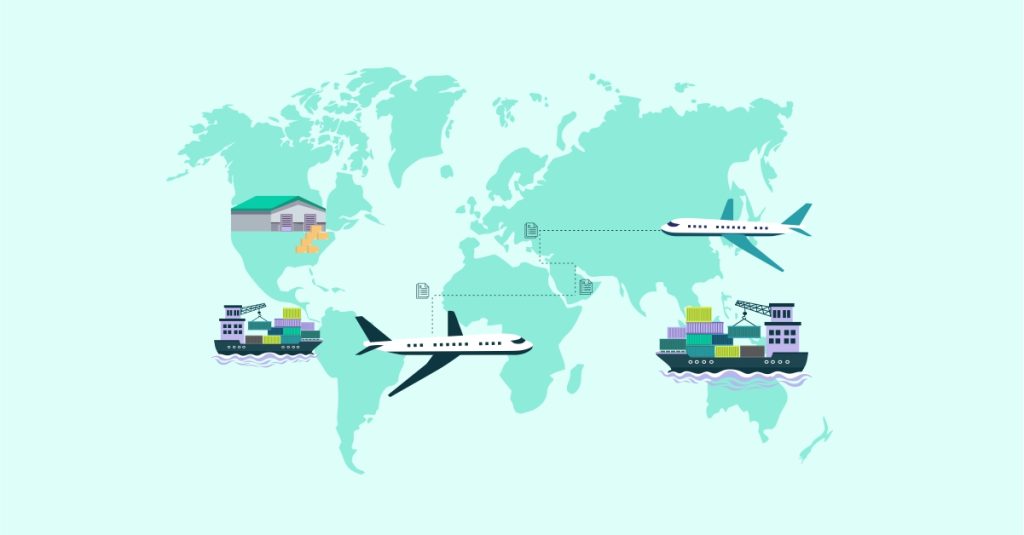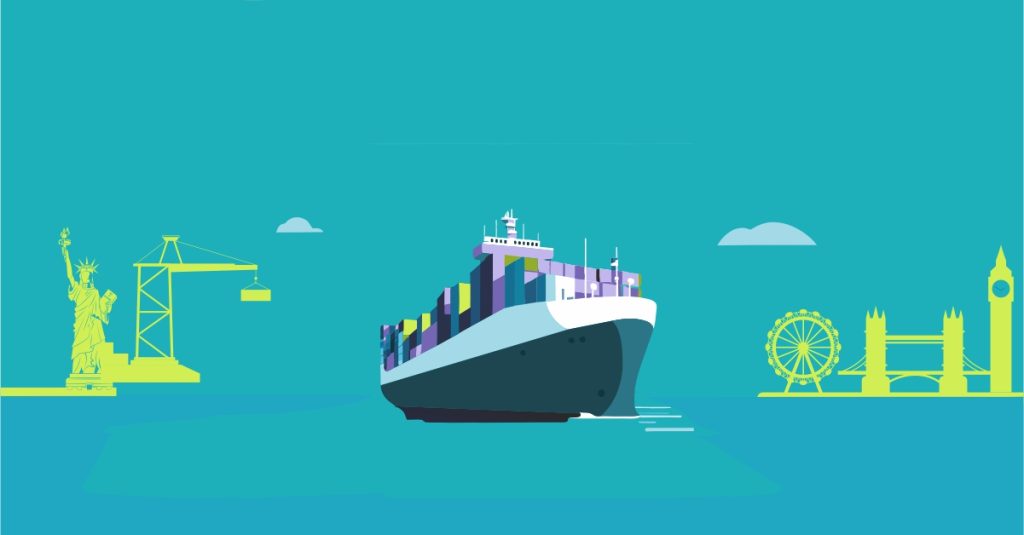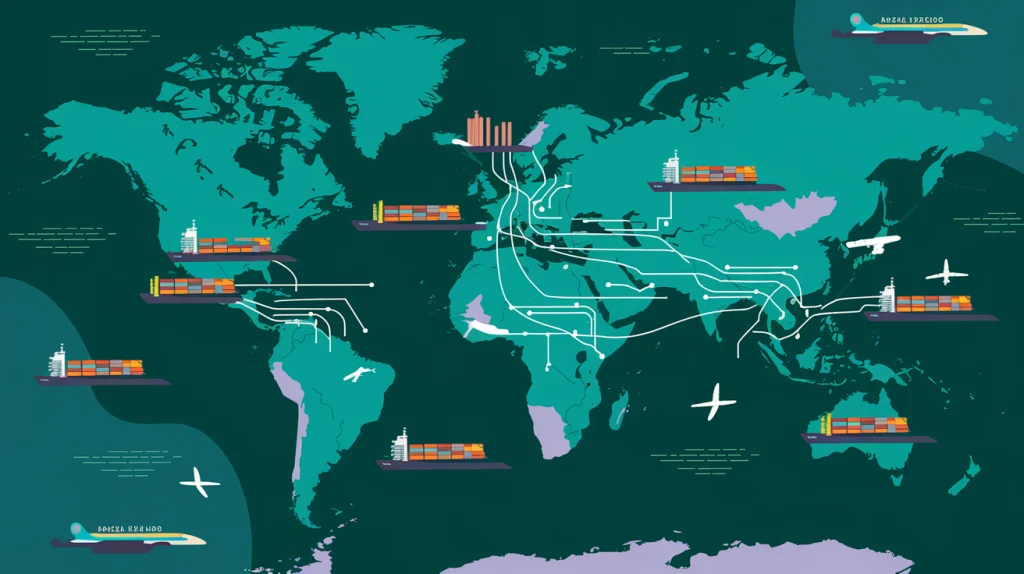A decade ago, digital freight forwarding strutted on the
logistics scene like a new kid in town. But fast forward to today, and it has
become the undisputed king of the shipping world.
But how and why?
Well, e-commerce is booming post-pandemic, and global trade
deals are multiplying, driving up the demand for efficient, tech-savvy freight
forwarding. The rapid growth of direct-to-consumer (DTC) e-commerce further
fuels this demand.
Yet, it’s not all smooth sailing. The logistics industry
grapples with staff shortages from pandemic-induced job shifts, port
congestion, and looming geopolitical conflicts. Nevertheless, technology is
helping it adapt. Now, it’s not just about moving cargo; it’s about digitally
connecting with customers to enhance business sales.
As a result, freight forwarders are increasingly adopting
digitization, and several factors are driving their growth. Moreover, the
digital freight forwarding trends for 2024 and beyond are promising. So, let’s
explore what to expect in this evolving landscape.
The Onward Journey of Digital Freight
Forwarding – Key Takeaways
- Growing Demand and Adoption- Digital freight forwarding will continue to grow and become mainstream—thanks to the booming e-commerce landscape. Moreover, the affinity of the VC investment world for those providing digital solution will carry on bolstering digital freight forwarding. Then the ratification of the new FTAs will require a reliable, easy, and agile supply chain mechanism, making digital freight forwarding all more important.
- Extensive Digital Transformation – Extensive digitization
is transforming digital freight forwarding by enabling real-time tracking,
issue resolution, and carrier selection. It analyzes data for optimal
service and cost efficiency. Moreover, seamless system integrations offer
end-to-end visibility, boosting customer service and confidence in the
logistics industry.
- LLM Deployments – Large
Language Models (LLMs) like GPT-4 are a strategic investment in digital
freight forwarding, improving communication and customer satisfaction.
They provide detailed, human-like responses, simplifying jargon and
offering round-the-clock support.
- Adopting In-House
Solutions – Digital freight forwarders are favoring in-house solutions to
gain operational control and better serve individual customer needs. These
solutions offer personalization, cost-efficiency, enhanced security,
real-time communication, leading to more reliable and efficient customer
service.
- Digitizing Documents with
Blockchain – The blockchain trend in the digital freight industry means
more transparency, security, and efficiency in freight services. It
enables better resource matching and offers a tamper-proof, decentralized
ledger for transaction records. This shift reduces paperwork, speeds up
processes, reduces errors, and provides valuable insights into complex
supply chains.
Factors Driving Digital Freight
Forwarders’ Growth
So, how big is the freight forwarding industry, and how much
do digital forwarders make up of it?
The digital freight forwarding market size is an 8% slice of
the pie, growing at a staggering 23.1% annually, leaving traditional freight in
the dust at 4.2%. But what are the factors that are
driving digital freight forwarders’ growth?
Let’s find out:
1. Centralization
Instead of the old-school method of contacting numerous
parties for shipment quotes, digital freight forwarding simplifies it.
Customers log into their application to access all necessary details in one
place. This saves time and facilitates informed decision-making by enabling
easy comparisons of pricing, transit time, carriers, and more.
Centralization also extends to other facets of shipping,
like booking, document management, and shipment tracking. This all-in-one
approach enhances transparency and efficiency in freight forwarding.
1. Interaction
Traditional supply chain interactions are often complex and
inefficient. Coordinating various suppliers, selecting carriers, and optimizing
deliveries in real-time can be daunting. Digital platforms like Unicargo simplify this
process, revolutionizing interactions between suppliers, customers, and
delivery services.
They integrate tools for delivery optimization and employ
robust analytics for smart routing and network optimization. Moreover, their
platform considers factors like shipment size, destination, carrier
performance, and market rates to find the most efficient route.
Real-time tracking and supply chain visibility further enhance efficiency, enabling quick decision-making and response to disruptions. This ensures that the cargo reaches its destination smoothly and that business owners can make smart decisions and adapt their operations according to real-time data.
2. Visibility
Digital freight forwarding leverages technology for
real-time shipment tracking, enhancing planning and decision-making. These
platforms gather and analyze data to spot supply chain trends and issues,
ultimately boosting efficiency and cutting costs.
A Newgate survey found that 50% of shippers
consider online visibility crucial for business planning and assess forwarder
services based on end-to-end visibility support. Lapses in visibility raise the
risk of delays and bottlenecks for freight forwarders.
However, digitalization combats these risks by maintaining
constant supply chain visibility. Furthermore, digital forwarders can swiftly
adjust to market changes and seize emerging opportunities, making them
well-prepared to act even outside periods of disruption.
3. Scalability
Digitalization empowers freight forwarders to scale
efficiently. Back-office tasks like email handling, freight tracking, and quote
generation are automated, freeing human resources for more strategic
contributions. As the Boston Consulting Group highlighted, digital
freight forwarders can expand their service offerings and geographical reach
more effectively.
These digital platforms foster global partnerships,
simplifying shipments to and from various locations. Shippers also benefit from
a broader selection of services and destinations courtesy of the extended
capabilities of digital forwarders.
4. Sustainability
Freight transport contributes 8% of global greenhouse gas emissions, a
figure set to double by 2050. However, digital freight forwarding can boost
efficiency by automating processes, optimizing routes based on real-time data,
and enhancing tracking to reduce waste and emissions.
Swift data sharing between stakeholders fosters
collaboration and informed decision-making. Whereas shippers benefit through
cost savings, like reduced fuel consumption and storage expenses.
Moreover, they can improve their brand reputation as
consumers prioritize eco-friendly practices. Adhering to emerging carbon
emission regulations also becomes easier with digital freight forwarding,
ensuring compliance.
5. Agility
Agility is vital in freight forwarding to enable quick
adaptation to industry changes. Digitization streamlines logistics by
consolidating quotations on one platform, saving time and reducing errors. It
boosts efficiency, allowing on-the-fly planning and rapid responses to demand
and supply fluctuations. This aids in swift issue identification and
resolution.
Freight-forwarding digital transformation fosters
adaptability, which is crucial in today’s fast-paced global economy. It enables
real-time response to supply chain disruptions and proactive issue mitigation.
Improved end-to-end visibility due to digitalization also
stabilizes global supply chains by connecting freight forwarders with carriers
and customers. While simplified processes and increased efficiency, lower
logistics costs, enabling shippers to provide better service.
Digital Freight Forwarding Trends for 2024
In the logistics industry, 2024 promises to be a year of
remarkable evolution and progress in digital freight forwarding. As we embrace
the future, several compelling trends are set to reshape the industry
landscape.
From the integration of digitized solutions & AI to the
relentless rise of e-commerce, 2024 is poised to be a year where innovation
meets necessity in freight forwarding.
Now, let’s explore how digital freight forwarding industry
trends continue to evolve in the logistics sector.
Digital Freight Forwarding Set to
Skyrocket: $76.24 Billion Market by 2028
In 2023, the digital freight forwarding market is valued at
around $28.47 billion. It’s projected to hit approximately $76.24 billion by 2028, with a solid growth
rate of 21.77% throughout this five-year forecast period.
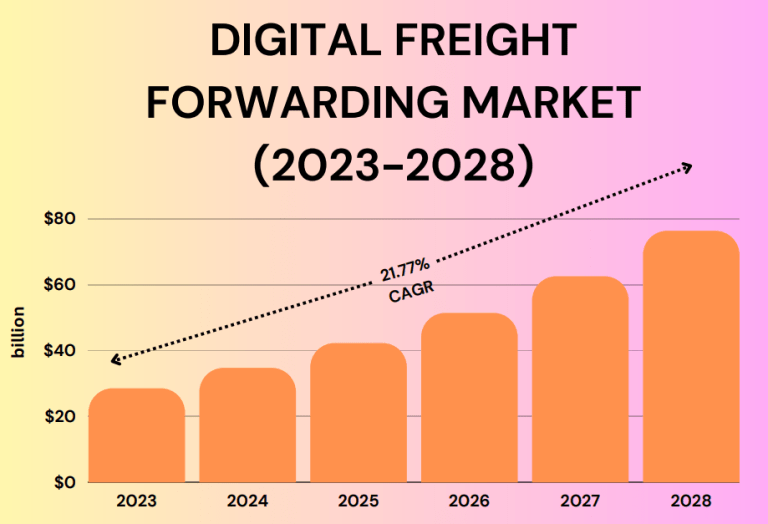
Source: Mordor Intelligence
This growth shows how digital freight forwarding services
are becoming more essential in today’s global trade landscape. Driving this
increase are certain factors like Free Trade Agreements(FTAs), investments,
e-commerce growth, and growing customer expectations.
1. Free Trade Agreements
More international trade deals and free trade agreements
have boosted cross-border commerce, increasing the demand for digital
forwarding services. For instance, the recent Australia-UK Free Trade Agreement
(A-UKFTA) became effective on May 31, 2023.
The agreement aims to reduce business input costs and ease
the cost of living pressure on consumers. It’s worth noting that over 99% of
Australian exports to the UK now enjoy tariff-free access.
FTAs drive e-commerce growth by simplifying global business
sales, making it more convenient and affordable. With e-commerce on the rise,
there’s a growing demand for efficient logistics solutions, and digital freight
forwarders are perfectly poised to meet this need.
2. Investments by Venture Capital Firms
In 2021, European companies grappled with lower sales and
higher costs due to ongoing Covid-19 restrictions and supply chain problems.
Consumer-focused businesses like retail struggled despite government aid.
Whereas technology and e-commerce companies thrived, driven
by increased digitalization during lockdowns. This indicates a growing need for digitalization, which has
captured the interest of Venture Capital firms. They are intrigued by the
potential for enhanced efficiency and customer service in digital freight
forwarding startups and are recognizing the value of innovative business
approaches.
For instance, a Portuguese startup recently obtained €1.8 million to streamline the freight
forwarding process. While another Indian digital freight management startup
secured $12 million to advance digitalization in
freight forwarding.
3. E-commerce Growth
The rise of online shopping, especially in the wake of the
COVID-19 pandemic, has created a need for better logistics solutions. Growing
demand for both local and global products is driving e-commerce logistics.
Statistics also predict that global e-commerce will grow by 9.4% in 2024, reaching $7.5 trillion in total sales by 2026. Digital
freight forwarding, known for its ability to deliver goods quickly, automate
tasks for business owners, and make operations more efficient, is ready to meet
this demand.
Furthermore, DTC e-commerce is expected to boost the global digital freight forwarding market
in the coming years. This is because DTC e-commerce enables businesses to
connect directly with customers without an intermediary and provides real-time
tracking for transparent shipping.
Unicargo is a key player in the DTC e-commerce
landscape. Their advanced nationwide fulfillment centers ensure faster,
cost-effective shipping and well-placed warehouses speed up deliveries and cut
costs, elevating the overall customer experience.
With their customer-centric approach and services covering
international freight forwarding, customs compliance, and trucking solutions, they streamline
supply chain management and offer peace of mind.
4. Increasing Customer Expectations
As supply chains become more global and intricate,
businesses want faster delivery, more services, and personalized options. They
are drawn to digital freight forwarding because of its transparency and the
convenience of booking and managing shipments online.
Moreover, its customer-centric approach, tailored services,
advanced tracking, updates, and reduced paperwork are also the driving factors
leading to its growth.
Simultaneously, another significant trend in the logistics
sector is the adoption of in-house solutions by digital freight forwarders. It
holds the potential to directly benefit customer expectations by enabling
greater customization and flexibility in service offerings.
Digital Freight Forwarders Forge a New
Path: In-House Solutions Revolutionize Customization, Efficiency, and Control
Digital freight forwarders are increasingly embracing
in-house solutions, a trend set to continue through 2024 and beyond. This shift
is driven by their desire for operational control and the ability to meet
specific customer needs.
In-house solutions provide greater control, allowing
customization and technology adjustment to align with individual customer
requirements. For instance, DHL introduced “Saloodo,” their in-house digital solution for
freight forwarding. Meanwhile, Kuehne + Nagel offers “eShipAsia,” an FCL sea freight platform
designed specifically for shippers in the Intra-Asia region.
In-house solutions offer multiple advantages. They lead to
more personalized services, aligning with unique customer needs, and prove
cost-effective in the long run, reducing ongoing expenses associated with
third-party services. Additionally, they enhance security, giving companies
control over data protection.
Furthermore, in-house technology improves communication,
offering real-time updates and greater transparency. This complete integration
elevates reliability and efficiency, resulting in smoother and more dependable
customer service. Integrating AI and machine learning further enhances these
in-house solutions, boosting their capabilities and benefiting both service providers
and customers.
AI and Machine Learning Redefining
Logistics: A $771.38 Billion AI Boom Will Revolutionize Digital Freight
Forwarding by 2032
Compared to the past five to ten years, businesses today are
more willing to adapt and use technology in their supply chain processes. They
now ask questions like, “How can I plan my shipments better? How can I reduce
deliveries to my warehouse? How can I make the most of my containers? How can I
minimize returns?”
Due to the pandemic disruptions and the adoption of
cutting-edge technology in freight forwarding, the logistics industry has
transformed significantly. One standout innovation in this transformation is
AI, which has emerged as a game-changer.
In 2022, the worldwide machine-learning market hit $38.11 billion. Predictions say it will skyrocket to a massive $771.38 billion by 2032. That’s an estimated annual growth rate of 35.09% from 2023 to 2032.
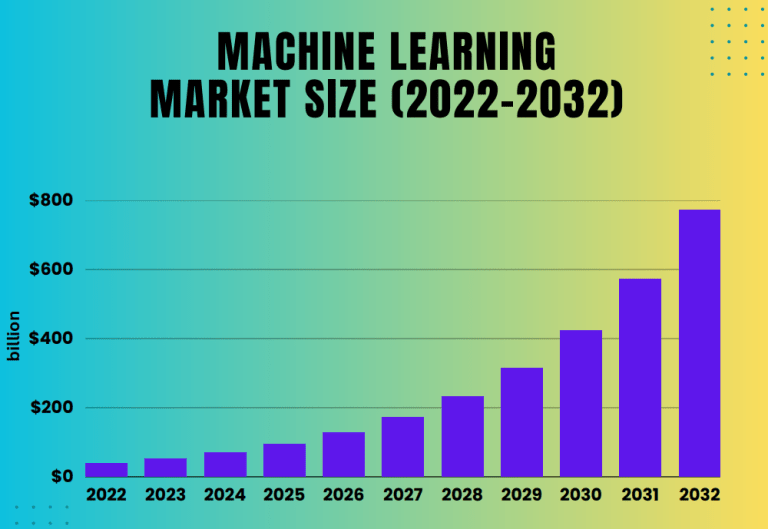
Source: Precedence Research
The ability of AI and Machine Learning’s ability to process vast data, predict outcomes, and make smart decisions has become profound in logistics. Here’s how AI and Machine Learning trends are expected to benefit shippers in 2024:
1. Computer Vision
Computer vision powered by AI is a hot trend in logistics. It’s a part of AI that lets computers and systems extract useful info from images and videos. These systems can take action or give suggestions by analyzing visual data with algorithms.
The computer vision market is booming, with forecasts indicating a value increase from $15 billion in 2022 to potentially $82.1 billion by 2032. According to DHL’s latest Trend Report, computer vision will be a standard part of logistics operations in the next five years.
In digital freight forwarding, computer vision can automate tasks like counting inventory or parcels, making supply chains faster and more precise. This tech simplifies and automates the measurement process, which is critical for storage, load planning, logistics, and shipping bills.
2. Warehouse Automation
The fusion of AI and robotics has brought major improvements in warehouse automation and will continue to do so in 2024. In fact, companies in the US, Canada, and Mexico are vying to adopt automation due to labor shortages.
AI-driven robots adeptly manage inventory sorting, picking, packing, and organizing, which speeds up order fulfillment. By 2024, nearly half of the medium to large warehouse and fulfillment center operators in the U.S. will employ robots.
3. Digital Freight Matching (DFM)
The trend of Digital Freight Matching platforms is on the rise in the logistics industry. In fact, the digital freight matching market is expected to hit $247.58 billion by 2030, with a 31.5% annual growth rate from 2023 to 2030.
The DFM platforms connect shippers, brokers, and carriers in a load-matching system, offering real-time updates on available loads and capacity. This empowers shippers and carriers to make informed choices based on current market conditions.
Additionally, some of these platforms allow shippers to track their shipments and get precise arrival estimates, enhancing customer service and operations.
Companies like Tata Motors are recognizing the value of DFM platforms. It has acquired a 27% stake in ‘Freight Tiger,’ a digital platform providing end-to-end logistics solutions.
4. Real-Time Visibility
One of the biggest turnarounds brought by digital freight forwarding is the development of all-encompassing visibility platforms for shippers. Such platforms enable real-time shipment tracking and A-Z updates of each shipment at every leg of its journey— ensuring transparency and facilitating immediate issue resolution.
Seamless system integrations providing end-to-end visibility and control are empowering the logistics industry to track shipments from start to finish, enhancing customer service and confidence.
An awesome instance is a digital freight solution offered by Unicargo that includes a tracking feature that gives you real-time updates on your shipment’s journey.
5. Predictive Analysis
In digital freight forwarding, AI-powered predictive analysis is gaining significant traction. It uses historical data, market trends, and other information to predict the future. By analyzing past order patterns and such, it can tell when a customer is likely to place an order.
This lets freight forwarders plan their logistics well in advance, ensuring on-time delivery. And that’s not all; it is helping optimize the entire supply chain, from transportation routes and warehouse storage to distribution schedules.
An example of predictive analysis is a freight predictive rate system developed by InData Lab that digs into a client’s Transport Management System (TMS). It uses this data to give insights on freight rates, but with a twist – it looks into the past. This allows forwarding managers to check the quote rate and make smart project decisions.
6. Strategic Optimization
AI and machine learning are empowering digital freight forwarders to crunch data and make smart moves. It is helping with big decisions like fleet specs, routing, and where to put warehouses. Plus, AI swiftly picks the best routes by considering traffic, weather, and delivery deadlines in real time.
Take UPS as an example. The company uses AI and machine learning to up its package delivery operations. They’re into predicting package volumes at different supply chain stages. This smart move helps them use resources better, reducing delays and making customers happier.
What’s more, automation is a big part of the digital makeover, cutting down on human errors and making ocean freight smoother. The Digital Container Shipping Association (DCSA) is working on setting standards to digitize ocean freight needs.
These include electronic bill of lading, IoT, cybersecurity, and port call optimization. They are designed to help improve operations, enable remote monitoring, and make it easier to communicate container load volumes.
These standards enable the automatic sharing of tracking information for containers equipped with IoT devices. Furthermore, LLM deployments can facilitate communication within the ocean freight industry.
LLM Deployment into Freight Forwarding to Enhance Customer Engagement and Efficiency
In digital freight forwarding, effective communication is paramount. Large Language Models (LLMs) like GPT-3 are not a passing trend but a strategic investment to enhance communication and customer satisfaction. LLMs differ from traditional chatbots; they offer detailed, context-aware responses and a more human-like interaction.
In the coming years, LLMs can enhance customer interactions with digital freight forwarders. For example, integrating them into digital forwarders’ websites will significantly improve client communication. They will handle shipment inquiries, offer instant and precise updates, and even help with bookings, elevating the overall customer service experience.
The best part is their round-the-clock availability, ensuring client inquiries are addressed promptly, day or night, ultimately benefiting both service providers and their customers. These smart models can sift through vast data sources to predict trends, spot bottlenecks, and recommend optimizations. This will make processes like analyzing global supply chains and anticipating disruptions convenient.
LLMs can also automate various freight forwarding tasks, including documentation, customs clearance, and coordination among different parties. By dissecting data and trends, they’ll become valuable decision-making partners, suggesting optimal routes and cost-effective transportation methods.
Additionally, LLMs can be crucial in staff training, offering support through answering queries and providing essential information. Furthermore, adopting blockchain technology can complement LLM deployments in digital freight forwarding by enhancing the security, transparency, and efficiency of data management and communication.
Enhancing Transparency and Automating Document Flow for Digital Freight Forwarding through Blockchain Integration
The move toward digitizing and exploring blockchain for document management in the digital freight sector is a trend to watch. Forwarders should seriously consider its benefits as this could lead to more transparent, secure, and efficient freight services down the road.
Blockchain maintains an unchangeable record of every transaction on a shared ledger, enhancing transparency. For instance, DHL and Accenture are working on a platform that tracks medicine production, transportation, and storage, ensuring data legitimacy through blockchain.
Their platform aims to enhance drug supply chain transparency, combat counterfeiting, and speed up processes. It can process a significant number of serial numbers at high speed, potentially saving lives and money.
Moreover, adopting blockchain over paper-based processes in the freight industry can expedite operations and reduce errors. It has the potential to boost tracking in complex supply chains, offering valuable insights on product quality and condition to both buyers and sellers.
Blockchain’s integration, though challenging, will prove a powerful asset for efficient SCM, fostering market growth from 2019 to 2023. Back in 2017, big food players like Walmart partnered with IBM to test blockchain in their logistics, starting with mangoes from Mexico and pork from China. It worked so well that they plan to bring blockchain into all their food chains.
Conclusion
The old-school freight world is quickly catching up with today’s digital innovations like Digitization, AI, Machine Learning, and other advanced solutions. This surge is driving significant growth, outpacing traditional freight methods.
At Unicargo, we always take the future of logistics and its potential requirements into account. Therefore, we’re spearheading the seamless integration of digital tracking platforms with the wealth of knowledge and expertise possessed by our dedicated freight forwarding professionals.
This synergy ensures a steadfast commitment to excellence, enabling us to swiftly address any challenges that may arise in the intricate realm of logistics. This forward-thinking approach makes Unicargo stand as the epitome of efficiency and reliability in the freight forwarding industry.
Join us at Unicargo. Submit a Request and get the best quotation from our team of experts!
